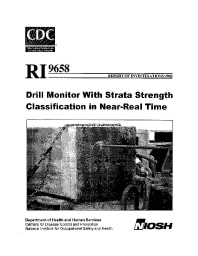Mining Publication: Drill Monitor With Strata Strength Classification in Near-Real Time
Original creation date: July 2002
Authors: WK Utt, GG Miller, WL Howie, CC Woodward
NIOSHTIC2 Number: 20022074
U.S. Department of Health and Human Services, Public Health Service, Centers for Disease Control and Prevention, National Institute for Occupational Safety and Health, DHHS (NIOSH) Publication No. 2002-141, Report of Investigations 9658, 2002 Jul :1-14
The process of drilling and bolting the roof is currently one of the most dangerous jobs in underground mining, resulting in about 1,000 accidents with injuries each year in the United States. Researchers from the Spokane Research Laboratory of the National Institute for Occupational Safety and Health are studying the use of a drill monitoring system to estimate the strength of successive layers of rock and assess the integrity of a mine roof so that roof drill operators can be warned when a weak layer is being drilled. Measurements taken during the drilling can be converted to suitably scaled features so that a neural network can classify mine roof strata in terms of relative strength. The feasibility of this concept has been demonstrated in the laboratory. The research project was undertaken in order to increase the safety of underground miners, especially those involved in roof bolting., The system should be applicable to the mobile drills used in underground mining and would likely find wider application as well.

NIOSHTIC2 Number: 20022074
U.S. Department of Health and Human Services, Public Health Service, Centers for Disease Control and Prevention, National Institute for Occupational Safety and Health, DHHS (NIOSH) Publication No. 2002-141, Report of Investigations 9658, 2002 Jul :1-14
- Computer Simulation of Ground Behaviour and Rock Bolt Interaction at Emerald Mine
- Evaluations of a noise control for roof bolting machines
- The Evolution of Drill Bit and Chuck Isolators to Reduce Roof Bolting Machine Drilling Noise
- Ignition Hazard From Internally-generated H2 in Sealed Mining Equipment
- In-Mine Test of the Bureau of Mines Preproduction Wireless Survey System
- Neural Network Technology for Strata Strength Characterization
- Roof Monitoring Helps Prevent Injuries in Stone Mines
- Snake Robot for Mine Rescue
- Sound Power Level Study of a Roof Bolter
- Technology News 505 - NIOSH Releases New Coal Mine Roof Rating Software